
Hiring Trends Index: a look at the recruitment landscape of Q1 2022
Hiring Trends Index – key findings at a glance
With vacancies continuing to be at a record high, employers face key challenges of labour and skills shortages, retaining staff and staff absence, which is also impacting workers, in particular their mental health and wellbeing. 41% of businesses increased recruitment over the last three months, an increase from 38% in Q4 2022, and 11% introduced a new hiring model. The majority of businesses plan to keep up their recruitment looking forward, with only 4% planning to decrease recruitment in Q2 2022. Although recruitment is on the increase, 21% of businesses also saw an increase in total hours worked, suggesting workload is high among a significant number of businesses. 36% of businesses are also aiming to improve the quality of applications they receive in the coming quarter. This has increased from 28% in Q4 2022, highlighting persistent skills shortages. Despite this challenge, 53% of businesses reported they are confident that they will recruit the people they need in Q2 2022.
Although recruitment is on the increase, 21% of businesses also saw an increase in total hours worked, suggesting workload is high among a significant number of businesses. 36% of businesses are also aiming to improve the quality of applications they receive in the coming quarter. This has increased from 28% in Q4 2022, highlighting persistent skills shortages. Despite this challenge, 53% of businesses reported they are confident that they will recruit the people they need in Q2 2022.
Top takeaways from the Hiring Trends Index Q1 2022
- One in ten (11%) employees are leaving their jobs due to high workload, according to employers
- A quarter of employers are concerned about the mental wellbeing of staff
- 27% of employers say skill shortages are a key challenge. As a result, 38% of staff are saying workloads are unmanageable due to open vacancies in their team
- Almost half (46%) of workers want to see more staff employed to make their workload more manageable
- 60% of UK workers reported feeling tired or drained and 40% say their work is the biggest negative impact on their mental health
The last three months
The number of vacancies reached a new record high from January to March according to the latest ONS data, although the rate of growth has slowed since the last quarter. The majority of businesses took 4-5 weeks to hire (22%), and 35% reporting it took them 6 weeks or more, highlighting an overall lengthy hire time. In fact, the mean average time to hire for Q1 was 6.04 weeks, showing an increase on 4.3 weeks in Q4 2021. Positively though, only 10% had to pause recruitment in comparison to 24% in Q1 2021, highlighting how far business recovery has come since the start of the pandemic. Only 22% did not recruit in Q1 2022 whereas 32% didn’t recruit at all in Q1 2021, displaying the increased health of recruitment compared to last year. Hiring remains relatively high across all sectors with two fifths (41%) of businesses increasing their recruitment with a notable increase of hiring in hospitality and leisure, retail and media/marketing/advertising/PR and sales. One of the biggest recruitment increases has been in the hospitality and leisure industry which has increased recruitment by 52% in Q1, 11% higher than the industry average and a 38% increase from Q1 2021 (14%). 21Recruitment in Q2 2022
Following on from the trends of Q1 2022, 30% of businesses plan to increase recruitment in Q2 2022, with a quarter (26%) of businesses intending to increase recruitment spending for specialist roles. 53% of businesses are confident they will recruit the staff they need in the upcoming quarter, a decrease of only 1% since Q4.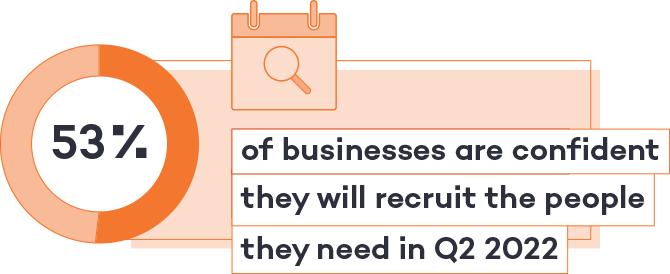
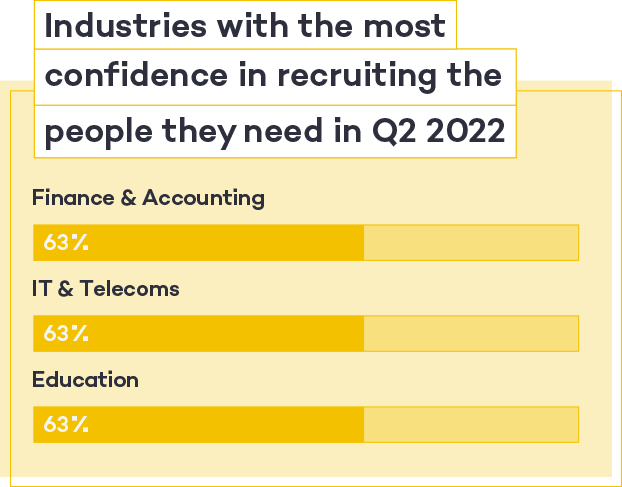 Industries with the most confidence in recruiting are finance & accounting, IT & telecoms & education (all 63%), closely followed by legal and media/marketing/advertising/PR and sales (both 62%). Interestingly, the industry with the least confidence they will hire the people they need is hospitality and leisure. In the wake of hybrid working, some hospitality staff have changed sectors in pursuit of more flexibility.
Industries with the most confidence in recruiting are finance & accounting, IT & telecoms & education (all 63%), closely followed by legal and media/marketing/advertising/PR and sales (both 62%). Interestingly, the industry with the least confidence they will hire the people they need is hospitality and leisure. In the wake of hybrid working, some hospitality staff have changed sectors in pursuit of more flexibility.
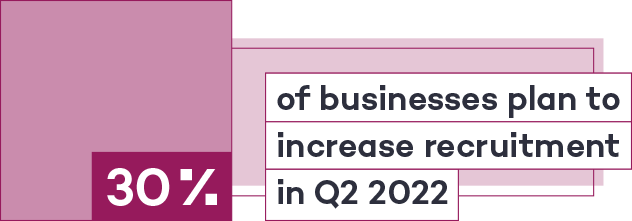 The majority of HR Decision Makers report that retaining staff and skills shortages and are the two greatest challenges they face in Q2 2022. Many employers (36%) are interested in improving the quality of applications, both from internal and external applicants. Businesses have also placed more focus on retention, with almost a quarter (23%) of businesses planning to implement practical ways to improve employee engagement. Despite this though, 31% of businesses don’t plan to take any actions by the end of Q2 2022 from a HR/recruitment perspective.
The majority of HR Decision Makers report that retaining staff and skills shortages and are the two greatest challenges they face in Q2 2022. Many employers (36%) are interested in improving the quality of applications, both from internal and external applicants. Businesses have also placed more focus on retention, with almost a quarter (23%) of businesses planning to implement practical ways to improve employee engagement. Despite this though, 31% of businesses don’t plan to take any actions by the end of Q2 2022 from a HR/recruitment perspective.
Mental health and wellbeing
With a quarter (25%) of employers concerned about the mental health of staff, and 40% of employees stating that their job is the biggest factor that is negatively impacting their mental health, wellbeing is an increasingly important factor for businesses to be mindful of. Despite this, 35% of businesses are planning to offer the same wellbeing support as they always have.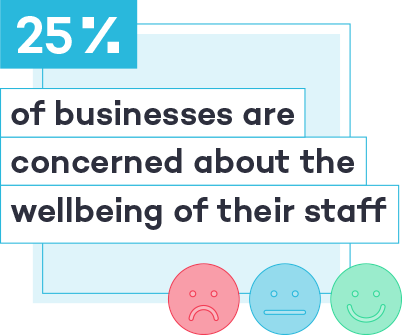 For some people, work negatively impacting their life contributes to a decision to leave a job, exacerbating skills shortages for businesses. Only 8% of people said stress levels would not impact their decision to leave a job, and 36% said stress would be a contributing factor in their decision to leave their job. Despite this though, 35% of businesses are planning to offer the same wellbeing support as they always have.
For some people, work negatively impacting their life contributes to a decision to leave a job, exacerbating skills shortages for businesses. Only 8% of people said stress levels would not impact their decision to leave a job, and 36% said stress would be a contributing factor in their decision to leave their job. Despite this though, 35% of businesses are planning to offer the same wellbeing support as they always have.
 According to employers, the majority of people who left their job since the start of 2022 did so for a higher salary, and only 7% were leaving for mental health reasons. However, employers may not be aware of the actual figures as many employees may not feel confident in sharing that they left their job due to mental health or stress related reasons. This is shown by the fact that 13% of employees claimed they have either left their job in the past due to stress and lack of wellbeing support and 9% stated they would leave their job as a direct result of stress levels or lack of support.
According to employers, the majority of people who left their job since the start of 2022 did so for a higher salary, and only 7% were leaving for mental health reasons. However, employers may not be aware of the actual figures as many employees may not feel confident in sharing that they left their job due to mental health or stress related reasons. This is shown by the fact that 13% of employees claimed they have either left their job in the past due to stress and lack of wellbeing support and 9% stated they would leave their job as a direct result of stress levels or lack of support.
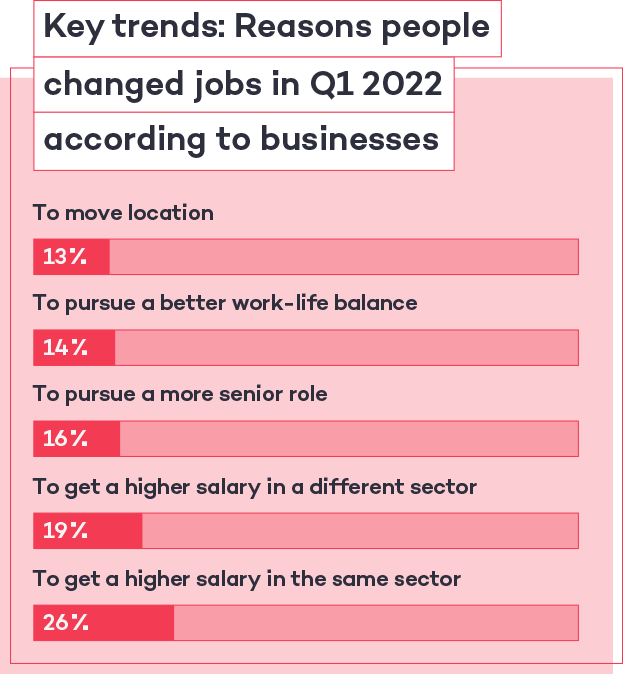
Skill shortages and workload management
38% of staff say that their workload is high or “unmanageable” as a direct result of staff shortages. Similarly, 35% feel there is a lack of support in their role from a stress management and wellbeing perspective. 60% of workers are feeling tired or drained and 37% are feeling overwhelmed highlighting that an unmanageable workload is having a clear impact on staff wellbeing.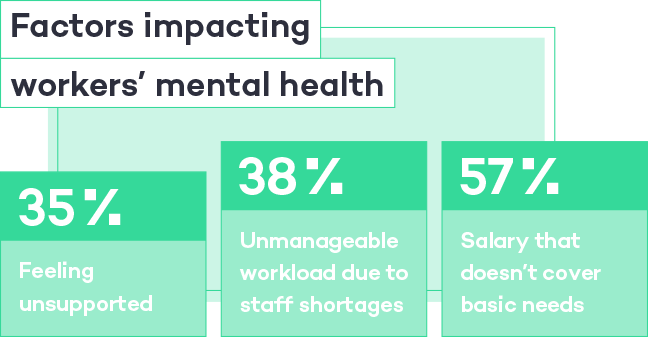 On the other hand, 49% of people felt comfortable in speaking to their manager about the support they need, meaning communication between managers and their teams is certainly in a good place. More generally however, there may be a disconnect, as only 26% of people felt their employer has placed more focus on wellbeing since the start of 2022. It is certainly positive to see employers encouraging staff to take time off to benefit their mental wellbeing, with 13% offering this for the first time, and 17% are planning to offer more wellbeing support in Q2, with over a third (35%) offering the same level they always have.
On the other hand, 49% of people felt comfortable in speaking to their manager about the support they need, meaning communication between managers and their teams is certainly in a good place. More generally however, there may be a disconnect, as only 26% of people felt their employer has placed more focus on wellbeing since the start of 2022. It is certainly positive to see employers encouraging staff to take time off to benefit their mental wellbeing, with 13% offering this for the first time, and 17% are planning to offer more wellbeing support in Q2, with over a third (35%) offering the same level they always have.
Salary concerns
With the cost of living still on the rise, unease around salary remains one of the largest concerns, with 57% of UK workers being worried that their salary doesn’t go far enough to cover basic needs like household bills. As mentioned, according to employers, people are leaving their roles for reasons related to salary, 26% believe that the pursuit of a higher salary in the same sector and 19% leaving to secure this in a different sector are the top reasons people are leaving their current roles. Of course, salary is an important factor however this is not the only factor when it comes to retention and recruitment. In our recent ‘Salary Squeeze’ report, we undertook an in-depth analysis of how the cost of living is affecting workers, and offered insights and advice on how employers can support their staff during this economic change. Read the article for a snapshot of our cost of living research. Download the report for in depth research on the cost of living.The importance of offering wellbeing support
Generally, businesses understand the importance of offering wellbeing initiatives, and the impact wellbeing can have on a workforce. In the Q4 edition of the Hiring Trends Index, 69% of businesses increased their focus on staff wellbeing in 2021, and 36% of businesses expected this to increase further in 2022. In the latest Hiring Trends Index, 12% of employers claim they do not know the correct wellbeing support to offer to staff so ensuring businesses are being mindful of wellbeing initiatives is becoming increasingly important.Wellbeing support businesses can offer
Results from our survey concluded that 53% of UK workers would like to see mental health days off, which is currently only an option for 8% of staff. Almost half of UK workers (46%) wanted to see additional people hired to help make their workload more manageable, which would likely reduce the high percentages of people feeling tired, drained, and overwhelmed, while increasing workplace motivation and improving working relationships. A third (33%) of staff want to see more open conversations around mental health in the workplace. Positively, 30% feel their employer is already promoting this. Employers can prioritise staff wellbeing by being mindful that high workload can have an impact on mental wellbeing. This can add to the cycle of stress for employees, as an unmanageable workload could lead to increased staff absences, that may affect other members of that team who are already facing heightened workloads due to unfilled vacancies. It is important to look out for the signs and symptoms of stress, including presenteeism, procrastination, lack of sleep, isolation, and low mood. Almost a quarter (24%) of staff would like to see mental health first aiders introduced, while 29% of employees do not feel that this would improve their mental health or wellbeing at work. Establishing mental health first aiders and incorporating them within the business to support employees can be beneficial for employees, and act as a preventative method. Other ways businesses can support the mental wellbeing of staff:
Other ways businesses can support the mental wellbeing of staff:
- Encouraging staff to take time off or take breaks that would benefit their mental health
- Promoting healthy and mindful activities such as meditation classes, yoga and other exercise options, which a third (32%) of UK workers want to see
- Directing staff to mental health advice or charities, or partner with them to best find ways to support staff
- Offering training for managers on how to spot the signs of poor mental health and ways they can support their staff
- Becoming aware of national events that can support with mental health solutions (e.g. Mental Health Awareness Week
Totaljobs CEO, Jon Wilson, comments on the Hiring Trends Index Q1 2022 edition
It’s clear that the number of open vacancies is starting to be felt by workers – with many feeling the impact of an unmanageable workload. This, combined by the ongoing anxiety and strain caused by the cost-of-living crisis, means that the wellbeing of workers is a priority, and businesses need to do their bit to create an environment where people feel their voices are heard and their mental health cared for. While employers are making good strides in offering wellbeing initiatives, skills shortages mean that many workers will continue to feel the pressure of empty seats in their teams. As a result, employers will be focused on shortening their time to hire, while supporting existing staff who may be taking on higher workloads in the interim.
About the research
Now in its second year, the Totaljobs Hiring Trends Index is a quarterly deep-dive into the trends that are shaping businesses now, and in the months and years to come. The Q1 2022 edition asked HR Decision Makers about their recruitment plans and experiences from January-March 2022 and looks ahead to the next three months in the labour market, as well as zeroing in on the all-important topic of wellbeing in the workplace.HR Decision Makers sample
All figures, unless otherwise stated, are from YouGov Plc. Total sample size was 1,000 senior HR decision makers in British businesses. Fieldwork was undertaken between 31st March – 13th April 2022. The survey was carried out online.UK workers sample
All figures, unless otherwise stated, are from YouGov Plc. Total sample size of UK working adults was 2,582. Fieldwork was undertaken between 8th – 12th April 2022. The survey was carried out online. The figures have been weighted and are representative of all UK adults (aged 18+).Receive the latest resources and advice to boost your hiring
By providing us with your details you agree to our privacy policy and for us to keep you updated with the latest news, events, and special offers from Totaljobs.

